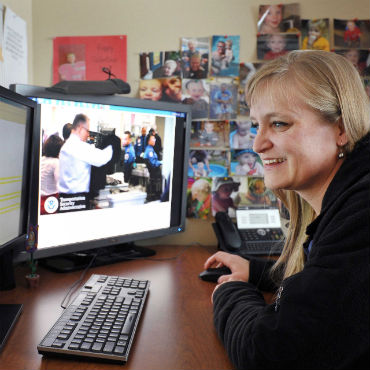How Sandia researchers get inside TSA employees' heads

The national lab is applying cognitive psychology and neuroscience to the field of airport security.

Researcher Ann Speed has been studying transportation security officers' state of mind as they screen baggage for prohibited items.(Photo: Sandia National Labs)
One of the top federal research labs wants to put its unique set of data analysis and engineering skills to work to help other agencies make their operations more efficient.
One of Sandia National Labs' most recent data research projects illustrates that capability. In that assignment, Sandia researcher Ann Speed harvested airport security checkpoint imaging data from the Transportation Security Administration's routine operations and employed it in internal tests that could ultimately help sharpen TSA's performance.
Speed explained that Sandia's research for TSA could change how the agency screens passenger baggage at hundreds of airport security checkpoints. The research focused on the efficiencies of threat detection when transportation security officers switched from regular security lanes to Pre-Check lanes, which allow pre-screened passengers to pass more quickly through the security process. Sandia gauged whether there was an impact on TSOs' thought processes after they switched lanes that might change their perception of bags moving through the checkpoint. The test could show how expectations can affect decisions, said Speed, using statistical analyses of how TSOs identified prohibited items in some of the images.
Speed used several computers for the lane-change study, loaded with software that allowed her to present about a thousand images of baggage X-rays to groups of up to 200 TSOs, who gauged the baggage's threat level. The experiments involved statistical analyses of how effectively the officers identified prohibited items found in some of the images.
According to Speed, the human influence on technology systems is critical to how systems operate. "More and more around the labs, people are starting to realize that the human element can be just as important as the hardware, software or engineering," she said.
"This kind of data collection and analysis can tell us how officers are making their decisions, their accuracy, and the rate of false alarms," Speed said. "We're capturing and analyzing their responses and decision times in different operational environments. In the end, the data inform us and our customer about the factors that impact officers' accuracy."
TSA has funded Speed's work since 2009, with additional money coming from the Department of Homeland Security's Science and Technology directorate. The lab also does a significant research for the Department of Defense.
According to Speed, Sandia is well qualified to study the interaction of hardware, software and humans. The facility not only has engineering and IT specialists, but also dozens of researchers with expertise in cognitive psychology and neuroscience.
Sandia, overseen by the Department of Energy, has a history of considering human psychology and technology in researching and developing nuclear and radiological security systems and other security-related technologies. Those skills, Speed said, can address federal agencies' questions about the impact of technology on human users and vice versa.
The next step in the TSA research will be introducing eye-tracking technology to gauge how TSOs physically view the X-ray images, where they are looking, how long they look and the time they spend looking.
In the future, Speed hopes to take the testing out of the laboratory to actual security checkpoints to inject more realism into the process. TSOs, she told FCW, will view the baggage images on a computer screen set up next to the actual checkpoint, to see how accompanying airport noise and other stress factors might affect results.
NEXT STORY: Which agencies reward innovation?


